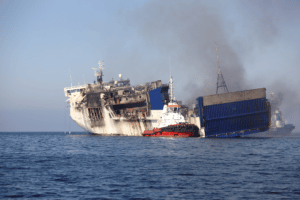Ferries are boats or ships that carry passengers and/or vehicles across bodies of water on regular and repeated round trips. Although these vessels are convenient for commuters in cities such as New York, accidents involving ferries occur frequently. In the U.S. and other countries, hundreds of persons are injured or killed in incidents involving ferries every year. Although ferry worker injuries sometimes occur even with the best caution, many injuries and even deaths happen because of the negligence of other parties, including employers and ferry owners.

Ferries – Convenient But Risky
Ferries come in many types and sizes, ranging from small water taxi boats to large roll-on, roll-off (Ro-Ro) vessels. They are used to convey people and vehicles in coastal cities such as New York or Seattle, and in communities or even states located in islands, such as Hawaii and many towns in Alaska. Ferries are used in most countries because they’re less expensive to build and operate than bridges or tunnels.
Sadly, accidents involving ferries are common. In 2013 alone, nine ferry accidents occurred in several parts of the world, including the sinking of a Philippine ferry after it collided with a cargo ship in August. That accident claimed over 100 lives.
In December 2013, a ferry in North Carolina ran aground on a sandbar near Battery Island, injuring more than a dozen persons.
In January 2014, 200 passengers died when a Sudanese ferry carrying refugees from South Sudan’s civil war sank in the Nile River.
Ferry accidents have many causes. Outside the U.S., many ferry incidents are the result of bad weather, human error, equipment failure, lax government oversight of ferry lines and reckless practices such as carrying too many passengers or cruising at high speeds.
Overcrowding was cited as a factor in the 1987 sinking of the ferry Dona Paz. This incident, known as Asia’s Titanic, resulted in an estimated death toll of 4,000 persons, the worst peacetime maritime accident in history. The Dona Paz was owned by Sulpicio Lines, Inc/Philippine Asia Span Carrier Corp. This company’s ship’s were involved in five ferry accidents that claimed over 5,000 deaths over the past three decades.
Common Causes of Ferry Accidents and Injuries
- Operating a vessel while intoxicated
- Operating a vessel under the influence
- Improper maintenance
- Mechanical failure
- Inexperienced operators
- Overloaded vessels
- Operator asleep at the controls
- Operator driving the vessel at high speeds
- Adverse weather conditions
Even when no catastrophic ferry accidents and injuries happen, ferry crew members face hazards every day. Many ferries operate in communities where climate conditions are extreme. In winter, ferries in states such as New York, Alaska, and Washington must operate in cold temperatures. Snow and ice builds up on decks and ladders, making them slippery and treacherous. Numerous seamen suffer injuries in slip and fall accidents that result under these conditions. Other common hazards in ferries include:
- Unsafe ramps
- Mooring lines
- Defects in non-skid surfaces
- Defective ladders
- Exposure to toxic materials
- Abandon ship (lifeboat) drills
Many of these defects are often avoidable. Unfortunately, negligence and corner cutting by owners and masters often create situations where ferries and their equipment become unseaworthy.
Common Injuries Caused by Hazards Aboard Ferries
Hazards aboard ferries can cause a variety of injuries. They can affect several body parts, including arms, hands, legs, feet, shoulders, back, neck and spine. Ferry accidents and injuries range in severity and type, depending on the nature of the incident. Along with minor cuts, bruises, and contusions, ferry crew members and longshore workers can also suffer from:
- Burns
- Sprains and strains
- Broken bones
- Crush injuries
- Amputations
A lot of these injuries may result in permanent disability that will not allow ferry crew members or other employees to return to work. In addition, minor injuries can cause workers to lose days of work while they receive medical treatment.
Compensation for Ferry Accidents and Injuries
Seamen and other maritime employees who suffer injuries while working on a ferry have the legal right to pursue compensation. General maritime law and the Jones Act give seamen the right to file claims against captains, ship owners, or fellow crew members if their injuries result from negligence, or if the vessel was unseaworthy. Also, longshore workers who suffer injuries while providing services to a ferry receive coverage by the separate Longshore and Harbor Workers Compensation Act.
Please fill out our contact form to learn more how we can help.
Sources:
- http://www.nyc.gov/html/dot/html/ferrybus/staten-island-ferry.shtml
- http://www.nydailynews.com/new-york/staten-island-ferry-crashes-manhattan-article-1.1517458
- http://www.mapreport.com/subtopics/d/ferry.accident.html
- http://www.cnn.com/2013/12/17/us/north-carolina-ferry-runs-aground/
- http://www.nytimes.com/2014/01/15/world/africa/south-sudan.html?_r=0